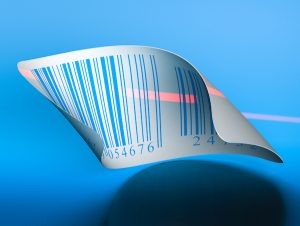A barcode is a machine-readable pattern that is applied to products, packages and parts. Today, they are on virtually everything, even the labels that are applied to fruits and vegetables. They contain data used for informational and marketing purposes, as well as for tracking products throughout their lifecycle.
Originally patented in 1952, barcode reading technology wasn’t used until 1974. The first product was a pack of Wrigley’s gum, and was scanned at a Marsh supermarket in Ohio. Today, barcodes come in many different formats, from a single row of lines called a 1-D (one dimensional) barcode to dots and squares that form a 2-D (two-dimensional code; QR (quick response) and DataMatrix codes are among the most popular 2-D codes. The more advanced 2-D code allows users to store and retrieve a much larger amount of data than realized with a 1-D code. This is because 1-D codes only contain data in the horizontal direction, whereas 2-D codes contain information both vertically and horizontally.
Barcodes can be found in most industries. For example, barcode applications have changed the face of manufacturing, processing, and tracking in the food and beverage, packaging, retail, distribution, medical, pharmaceutical, electronics, automotive and aerospace industries. Found in every electronic and consumer product, from your cell phone battery to the box holding your new running shoes, barcodes are everywhere. The use of 1- or 2-D codes reduces overhead costs by automating and simplifying supply chain management, inventory, check-out and purchasing.
In recent years, governments around the world have begun requiring medical devices and pharmaceutical manufacturers to apply machine-readable codes on all packaging, down to individual medical containers. Should a defective product reach a store shelf, automated tracking of each package will accelerate safety recalls while making quality-control data available to the entire supply chain.
1-D barcodes were the first barcode implemented worldwide. They are linear codes, and only contain alphanumeric data. Each character in the code represents something different about the product, and a database provides information on what each character means.
In almost all cases, 1-D barcodes are read from left to right. The widths of the spaces and bars relate to a specific character in the barcode. The white space to the left and the right of the barcode is known as the quiet zone or margin; this helps the reader locate the barcode.
Some common uses of 1-D barcodes are:
- Code 128 – used in logistics
- UPC-A – used in retail and supermarkets in the U.S.
- Code 39 – used in military and automotive
- Codabar – used in U.S. blood banks, photo labs, FedEx Airbills and libraries
- Postnet – typical usage for the United States Postal Service
Unlike 1-D barcodes, 2-D matrix codes contain information both horizontally and vertically. This allows them to store much more data. For example, a single 2-D code can hold up to 3,116 numeric characters or 2,335 alphanumeric characters, compared to the 39 characters that Code 39, a 1-D code, can hold.
Unlike 1-D barcodes, all 2-D codes have built-in error correction, similar to the check digits in some 1-D codes, which effectively eliminates misreads. Within a single 2-D DataMatrix code, the data is typically encoded three times, which significantly increases the chances the code will be read correctly. Vision enabled barcode readers would have to scan 10.5 million codes to misread a single 2-D barcode; laser scanners, which cannot read 2-D codes, cannot claim this level of accuracy.
Common 2-D codes include:
- DataMatrix – used in aerospace, defense, printed media as well as the U.S. Postal Service
- MaxiCode is a dot-based code – used in logistics applications
- QR Codes – used in automotive and commercial marketing applications
- Aztec – – used in ticket agencies and rental car companies
With all the different types of barcodes being used today, it’s important that the barcode reading technology being built into new and emerging systems include the highest-grade precision lens available. Our image and barcode scanning lenses are your best choice for short track length applications using both conventional and line scan sensors.